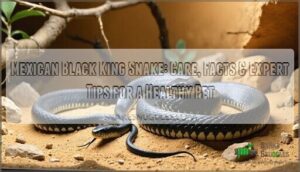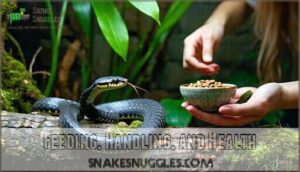This site is supported by our readers. We may earn a commission, at no cost to you, if you purchase through links.

You’ll recognize this beauty by its jet-black, glossy scales that shimmer with occasional iridescence – no bands or patterns like other kingsnakes.
These secretive hunters are legendary for their immunity to venom, allowing them to prey on rattlesnakes and other venomous species.
In captivity, they’re surprisingly docile and require straightforward care: a 48-inch enclosure, 85-90°F basking spots, and 50-60% humidity.
Adults typically reach 3-4 feet and can live 15-20 years with proper care. Their pure obsidian appearance develops as juveniles shed their faint speckles, transforming into living shadows.
Understanding their unique thermal regulation and feeding behaviors reveals the secrets to keeping these desert gems thriving.
Table Of Contents
- Key Takeaways
- Mexican Black King Snake Overview
- Natural Habitat and Behavior
- Housing and Environmental Needs
- Feeding, Handling, and Health
- Unique Facts and Care Tips
- Frequently Asked Questions (FAQs)
- Is a Mexican black kingsnake venomous?
- Are Mexican Black Kingsnakes aggressive?
- Are Mexican Black Kingsnakes docile?
- What temperature should a Mexican black kingsnake be at night?
- How can I prevent snake escapes?
- Is UVB lighting necessary for their health?
- What substrate works best in enclosures?
- How often should I clean their water bowl?
- Can multiple kingsnakes live together?
- Can Mexican black kingsnakes bite humans?
- Conclusion
Key Takeaways
- You’ll get a stunning, jet-black snake that’s completely docile and non-venomous, making it perfect for both beginners and experienced keepers who want a striking pet with minimal aggression.
- You’ll need a 48-inch enclosure with proper heating – maintain 85-90°F basking spots, 70-80°F cool zones, and 50-60% humidity to mimic their natural Sonoran Desert habitat.
- You can handle them easily once they settle in – while hatchlings might be defensive initially, adults become calm companions that rarely bite when handled properly 1-2 times weekly.
- You’ll feed them appropriately-sized rodents on a schedule of every 5-7 days for hatchlings, weekly for juveniles, and every 10-14 days for adults, avoiding the 48-hour window after feeding.
Mexican Black King Snake Overview
You’ll find the Mexican Black King Snake, Lampropeltis getula nigrita, is a striking, jet-black species native to the Sonora Desert region.
Its smooth, glossy scales and adaptability make it a fascinating subject for both new and experienced keepers.
Scientific Classification and Range
If you’re mapping out the king snake’s blueprint, here’s your cheat sheet:
- Taxonomy: Lampropeltis getula nigrita.
- Geographic Range: Southern Arizona to NW Mexico.
- Species Identification: Jet-black scales, rare in the wild.
- Habitat Distribution: Loves Sonora Desert rocks and dry grasslands.
- Conservation Status: Least Concern—these black king snakes thrive, helping balance their ecosystem while keeping black king snake care simple.
Understanding their proper care requirements is essential for a healthy pet.
Physical Appearance and Coloration
When you spot a Mexican black king snake, you’ll notice their smooth, jet black scales, sometimes boasting subtle iridescence under light.
Unlike other king snake species, this black snake breed stands out for its minimal snake markings and lack of color morphs.
Juveniles may show faint yellow or white speckling, but adults are pure, glossy black throughout, with a notable lack of distinct markings.
Size, Lifespan, and Growth
Growth rates vary, but your mexican black king snake can reach a mature snake length of 40 to 52 inches within its first three years.
Expect healthy weight gain as juveniles fill out.
Watch the aging process unfold as yellow spotting fades and scale development reveals a jet-black adult.
Like all king snake species, their robust size comes from a rich king snake habitat.
Natural Habitat and Behavior
You’ll find the Mexican Black King Snake roaming dry grasslands and rocky deserts, where it hunts other snakes with impressive skill.
Its secretive nature means you might’ve better luck spotting your lost sock than watching one in the wild, highlighting the snake’s secretive behavior and impressive hunting abilities, making it a challenge to spot in its natural habitat.
Native Range and Wild Habitat
You’ll find the Mexican black king snake making its home in the arid landscapes of northwestern Mexico and the Sonoran desert, thriving where rocky soils meet open woodlands.
Their Desert Ecology is all about using rodent burrows and shady crevices to beat the heat, illustrating classic king snake behavior and revealing just how well these kings adapt to harsh snake habitat types.
The Mexican black king snake’s ability to survive is linked to its understanding of desert habitat conditions, which is a key aspect of their harsh snake habitat and overall king snake behavior.
Diet and Predatory Adaptations
Mastering adaptive hunting in the wild, the mexican black snake shows off impressive prey capture skills.
It’s a true star on the snake species list, thriving on king snake feeding strategies and snake predation.
Thanks to venom immunity, you don’t have to worry—this king snake behavior lets it dine on venomous meals others wouldn’t dare.
Conservation Status and Ecological Role
When you look at the mexican king snake, you see nature’s cleanup crew in action.
Their king snake habitat needs wild places for ecosystem balance, and their snake immunity keeps venomous neighbors in check.
To support snake conservation, remember every effort in habitat preservation helps.
Here’s a snapshot:
- Wildlife Conservation laws
- Predator control
- Species adaptation
- Healthy king snake information sources
Learning about the snake care basics is essential for a healthy pet, and understanding wildlife conservation and habitat preservation can make a significant difference, while also considering species adaptation.
Housing and Environmental Needs
You’ll need to create a habitat that mirrors the Mexican black king snake’s natural desert environment, balancing space, temperature, and humidity.
Careful setup of lighting, heating, and ventilation prevents escape attempts and keeps your snake both healthy and stress-free.
Enclosure Size and Setup
Choosing the right Enclosure Design sets the stage for proper mexican king snake care.
Aim for a tank size of at least 48 inches long—think of it as prime real estate for your king snake habitat.
Good Ventilation Systems are a must. They prevent stale air and help regulate humidity control, supporting healthy routines, snake breeding, and overall king snake information management.
Proper snake enclosure designs often involve King Snake Enclosures to guarantee a suitable environment, which is crucial for king snake care and healthy routines.
Substrate, Humidity, and Water
Your substrate choice sets the foundation for proper Moisture Control and Humidity Levels. Create a Desert Soil mixture using 60% topsoil and 40% play sand for ideal drainage.
This blend supports mexican snake care by maintaining 50-60% humidity naturally. Provide a humid hide filled with moist sphagnum moss for shedding needs.
Place the water bowl on the cool side to prevent excessive evaporation while ensuring adequate Water Quality for hydration. Using the right desert soil mix is essential for maintaining the ideal environment.
Lighting, Heating, and Temperature Gradient
Your Mexican reptile’s lighting and heating setup creates the foundation for ideal health through proper Temperature Control.
UVB Lighting from T5 bulbs supports vitamin synthesis, while Heat Sources like halogen bulbs establish essential Thermal Gradients.
- Basking Spots: Maintain 85-90°F surface temperatures using overhead heating
- Cool zones: Keep ambient temperatures at 70-80°F for thermoregulation
- Night cycles: Allow natural temperature drops to 65-75°F
This mexican snake care approach mimics natural desert conditions perfectly.
For superior results, understanding snake care guides is essential to create a suitable environment.
Hides, Enrichment, and Ventilation
Your snake needs proper hiding places on both warm and cool sides to feel secure and regulate body temperature effectively.
Provide at least two snake hides—one humid hide filled with moist sphagnum moss for shedding support.
Environmental enrichment like artificial plants and climbing branches keeps this mexican reptile mentally stimulated.
Make certain adequate ventilation systems with screen tops or side vents to maintain airflow while preventing escapes.
This black snake species thrives when given proper thermal gradients and enrichment options, ensuring it has the necessary environment to live well, with proper thermal conditions.
Feeding, Handling, and Health
Proper feeding and careful handling form the foundation of successful Mexican black king snake care, directly impacting your snake’s health and longevity.
Understanding their dietary needs, temperament, and potential health concerns will help you provide ideal care while building a trusting relationship with your serpentine companion, based on complete concepts of snake care.
Diet and Feeding Schedule
Proper nutrition keeps your mexican black king snake thriving.
Feed hatchlings every 5-7 days, juveniles weekly, and adults every 10-14 days.
Prey items should match your snake’s widest body part – typically mice or rats.
Food size directly impacts nutrient needs and growth rates.
Meal planning prevents obesity while supporting healthy development in these black snake species.
Understanding feeding frequency guidelines is vital for maintaining healthy health in snakes.
Safe Handling Techniques and Temperament
Patience transforms handling from stressful encounters into peaceful connections.
You’ll want to handle your snake 1-2 times weekly, avoiding the 48-hour window after feeding or during shedding cycles.
Gentle handling techniques include washing hands beforehand and using a paper towel roll for initial contact.
These king snake types respond well to consistent, calm approaches that support stress reduction and proper snake taming through gradual temperament tests.
Common Health Issues and Hygiene Practices
Keeping your reptile pet healthy requires vigilance against common ailments that plague Mexican black kingsnakes.
Understanding these health challenges helps you provide better care for your scaly companion.
- Respiratory Issues – Watch for wheezing, mouth breathing, or nasal discharge when humidity exceeds 60% or temperatures drop below ideal ranges
- Skin Problems – Monitor for retained shed (dysecdysis) and scale rot, often caused by improper humidity control or dirty substrates
- Parasite Control – Schedule annual fecal exams to detect pinworms and coccidia affecting up to 30% of captive specimens
- Hygiene Tips – Clean enclosures bi-weekly with chlorhexidine solutions and remove uneaten prey within 6 hours to prevent bacterial growth
Breeding and Brumation
Successful breeding requires careful timing and temperature control.
You’ll need to simulate winter conditions through brumation, gradually reducing temperatures to 55-60°F for three months.
Breeding season occurs March through May, with females laying 6-20 eggs requiring precise incubation.
| Breeding Phase | Temperature Range | Duration |
|---|---|---|
| Brumation | 55-60°F | 3 months |
| Breeding Season | 75-85°F | March-May |
| Egg Incubation | 80-82°F | 60 days |
| Hatchling Care | 75-80°F | Ongoing |
| Temperature Control | Gradual changes | Critical |
This mexican snake facts showcase how reptile pet breeding mirrors Mexican food culture’s patience-driven processes.
Hatchling care demands immediate separation to prevent cannibalism, reflecting Mexico’s culinary traditions where timing determines success.
Temperature control throughout incubation prevents developmental issues, making precise monitoring essential for healthy offspring.
Unique Facts and Care Tips
You’ll discover fascinating details about your Mexican black king snake that go beyond basic care requirements.
These remarkable reptiles possess unique characteristics and behaviors that make them truly exceptional pets when properly understood.
Iridescent Scales and Color Variations
Your Mexican Black King Snake’s scales showcase remarkable iridescence that creates a stunning rainbow shimmer under proper lighting.
Scale patterns remain consistently smooth and jet-black, though juveniles display temporary yellow spotting that fades with maturity.
Unlike other color morphs found in Mexican snake facts, these serpents maintain their signature ebony appearance throughout life, making their scale shine particularly striking when healthy, due to their remarkable scale patterns.
Defensive Behaviors and Social Traits
When threatened, these serpents employ defensive coiling and snake posturing as their primary threat displays.
They’ll vibrate their tails against substrate, creating a vibrational warning that mimics rattlesnakes.
Unlike social hierarchy patterns in Mexican culture, these solitary creatures don’t establish social norms or family ties, preferring independence over community bonds.
Understanding their king snake temperament is essential for providing proper care and handling.
Expert Tips for Successful Husbandry
Master your snake care with proven husbandry tips that reveal successful ownership.
Consistent routines create stability, while proper enclosure design mimics natural habitats effectively.
- Feeding Strategies: Establish regular schedules and monitor prey size carefully
- Breeding Techniques: Maintain precise temperature cycles during brumation periods
- Snake Care: Record weights, shed dates, and behavioral changes consistently
- Enclosure Design: Provide secure hides and maintain ideal temperature gradients
Frequently Asked Questions (FAQs)
Is a Mexican black kingsnake venomous?
Don’t judge a book by its cover—Mexican black kingsnakes aren’t venomous at all.
They’re constrictors that squeeze prey and actually hunt venomous snakes, earning natural immunity to rattlesnake venom through evolution.
Are Mexican Black Kingsnakes aggressive?
Generally speaking, these snakes aren’t aggressive by nature.
You’ll find they’re typically calm and docile when properly handled, though they may become defensive if startled or threatened, like most snake species.
Are Mexican Black Kingsnakes docile?
You’ll find these snakes surprisingly docile once they’ve settled into captivity. While hatchlings might be defensive initially, adults typically become calm, easy-to-handle companions with regular interaction and proper care techniques.
What temperature should a Mexican black kingsnake be at night?
Nighttime temperatures should drop to 70-75°F for your snake’s comfort. This natural cooling mimics their desert habitat’s temperature fluctuations, promoting healthy sleep cycles and proper digestion.
How can I prevent snake escapes?
You’ll want to secure your enclosure with tight-fitting lids, proper latches, and front-opening designs. Check for gaps regularly, verify adequate ventilation without escape routes, and always double-check closures after maintenance.
Is UVB lighting necessary for their health?
UVB lighting isn’t strictly necessary for Mexican black kingsnakes’ survival, but it’s recommended for ideal health. It supports natural behaviors, vitamin D3 synthesis, and overall well-being in captivity.
What substrate works best in enclosures?
Coincidentally, substrate choice mirrors your snake’s desert origins perfectly. You’ll want a 60% topsoil and 40% play sand mixture, or Terra Sahara Bioactive Kit works excellently for creating natural conditions.
How often should I clean their water bowl?
You’ll want to refresh their water bowl weekly or whenever it looks cloudy or has debris floating around.
Clean water keeps your snake healthy and prevents bacterial growth that could make them sick.
Can multiple kingsnakes live together?
Can you house multiple snakes together? That’s like asking if roommates always get along perfectly!
You can’t safely cohouse kingsnakes because they’re cannibalistic by nature and will attack each other, requiring separate enclosures.
Can Mexican black kingsnakes bite humans?
Yes, Mexican black kingsnakes can bite humans, but they’re non-venomous.
You’ll likely experience minor puncture wounds that heal quickly.
They’re generally docile and rarely bite unless threatened or mishandled during feeding time, making non-venomous an important characteristic to remember.
Conclusion
Why settle for an ordinary pet snake when you can own nature’s most stunning serpent?
The mexican black king snake offers reptile enthusiasts a perfect blend of beauty and manageable care requirements.
Their glossy obsidian scales and docile temperament make them exceptional captive specimens.
With proper environmental conditions, appropriate feeding schedules, and regular health monitoring, these desert natives thrive in captivity for decades, making you invest in a remarkable companion that showcases the elegance of America’s southwestern wilderness.















